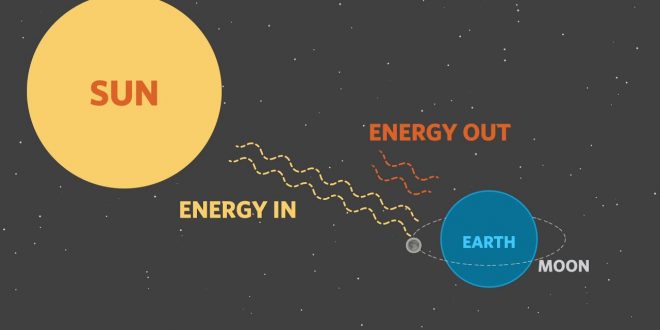Global Radiation Balance
There are various factors that influence the amount of radiation coming from the sun to the earth’s surface.
- Some of the radiation is reflected upward, some is scattered both upward and downward directions.
- Besides, some of the radiation is absorbed by the clouds and atmosphere.
- The rest of the radiation comes to the earth surface and becomes available for the vegetation.
- After coming to the Earth’s surface, radiation is used differently by the different components of the environment.
- Of the radiation coming to the Earth’s surface, some amount is absorbed by the terrestrial earth surface and atmospheric gases, some is used for evaporation, latent-heat and also for convection and conduction by the winds.
- Of the total radiation coming from the sun, on an average 50% comes to the earth surface and the rest of the 50% energy is reflected back to the space, scattered to both upward and downward, absorbed by clouds and atmosphere.
- After coming to the Earth’s surface, radiation is used by the different components of the environment.
- Thus, there is a balance between energy gain (+50U) and energy loss (-50U) at the surface of the Earth.
- Amount of radiation coming to the Earth’s surface varies between shortwave and longwave radiation.
- Radiation is largely influenced by clouds in the sky.
- Amount of radiation coming to the Earth surface also varies from place to place.
Amount of radiation coming to the earth surface varies between short wave and long wave radiation.
In case of shortwave Radiation
Best safe and secure cloud storage with password protection
Get Envato Elements, Prime Video, Hotstar and Netflix For Free
Best Money Earning Website 100$ Day
#1 Top ranking article submission website
- Total reflected and scattered to space: 30%
- Total absorbed: 70%
In case of longwave Radiation
- Total lost to space: 70%
- Total radiation at the surface: 30%
Clouds largely influence the radiation balance.
| Average sky condition | Clear sky condition (No cloud) | Cloud condition (Overcast) | |
| Reflected or scattered by surface or atmosphere |
30% | 13% | 51% |
| Absorbed by atmospheric clouds, gases, and aerosols |
25% | 17% | 24% |
| Absorbed by Surface Oceans and Land |
45% | 70% (55% direct, 15% diffuse sky) |
25% (4% direct, 21% diffuse sky) |
Radiation balance in the northern hemisphere
The passage of solar radiation through the atmosphere
- The following figure shows the mean values for various component of energy as they belong to the atmosphere of the northern hemisphere of the earth.
- If one considers 100 units of solar radiation passing through horizontal surface at the top of the atmosphere, then of these 100 units, on an average 52 units will be dealt with by the cloud.
- Clouds reflect back 25 units to the space, absorb 10 units and allow 17 units to reach on the surface of the earth.
- Atmosphere deals 33 units of which 9 units will be absorbed by the air and the rest 24 units will be allowed directly to reach at the ground surface.
- Of the rest 15 units, 9 units will be scattered upward and 6 units will be scattered downward reaching the ground.
- Thus, the total energy available to the ground will be on an average 47 units (Radiation flux is 0.228 Cal/cm2/min.)
- The warm surface of the earth also radiates heat from the ground very effectively. Of the 119 units radiated outwards from the surface, 15 units escapes to space and 104 units absorbed in the atmosphere. The atmospheric gases re-radiate this energy and send 104 units to the surface.
- On an average, the earth’s surface is giving 23 units of energy into the atmosphere by means of evaporation process.
- This energy is not lost from the earth because the moisture that is vaporized at the surface is recondensed in the form of clouds in atmosphere, thereby, giving back 23 units to the surface.
- Sensible heat is the heat transferred by convection because of wind flowing across the surface of the Earth.
- The winds across the surface carry away 9 units and deposit those 9 units in the atmosphere.
- Thus, there is balance between energy gain (+47U) and energy loss (-47U) at the Earth’s surface.
- All organisms on the Earth spend their entire life in a thermal radiation, infra-red heat exchange environment, convection and latent heat exchange.

Radiation flux
Radiation flux refers to the total amount of radiation energy of all wave lengths (short and long) crossing a unit area of surface per unit time. The radiation flux represents the principal input of energy. It is expressed as Cal cm-2min-1
Radiation flux or the radiation balance (S) may be positive or negative.
It has a positive value during the day when solar radiation is directly available but at night the situation becomes reverse i.e. radiation exceeds the counter radiation.
Therefore (-)S= c-b
Where,
c= atmospheric counter radiation
b=terrestrial radiation
Energy budget
Sunlight, thermal radiation, conduction and convection all interact with the organism on the surface. This interaction either deliver a net energy to the organism or causes absorption from it. Since energy is neither created nor destroyed and the surface itself has no capacity to store heat, the summation of all the fluxes is always zero
i.e.
S+G+LE+C=0
Where,
S = Solar radiation flux
G = Ground-surface flux (from conduction)
LE = Latent heat of evaporation flux
C = Surface-air flux (by convection)
Above equation expresses the various components of energy which reach on the surface of the vegetation.
Energy budget in different climatic zones of the world
The relative contribution of the various components of energy budget varies with geographical location and seasonal variation.
Energy budget in Equatorial continent
- Very near to the equator there is no great annual fluctuation of radiation balance except variations in cloudiness.
- In Brazil, there is almost constant soil moisture by precipitation (rainfall).
- The net radiation is used in evaporation.
- The net radiation amount almost is nearly constant all throughout the year.
(Image)
Energy budget in Equatorial monsoon
- In Saigon, Vietnam, in April, a maximum radiation is obtained before the commencement of monsoon.
- LE heat (Evaporation flux) decreases because of dry and hot air.
- This sudden rise in late winter may be due to the sudden disappearance of the cloud cover present throughout the year.
- This period of the year is characterized by the more gusty wind.
- Cyclone, tornedos are seen in this zone during this season.
(Image)
Energy budget in Tropical continent
- In tropical region, the net radiation shows a strong seasonal variation.
- A typical dry continental tropical region is Aswan, Egypt.
- Here, the rainfall is very small and has a negligible effect on the energy regime.
- The maximum net radiation in Aswan is less than Saigon.
- The desert conditions are usually dry, dusty and windy.
- Latent Evaporation heat is negligible due to hot and dry weather.
(Image)
Energy budget in Temperate latitude
- In Paris, France, the radiation is maximum in summer and minimum in winter and sometimes it becomes negative.
(Image)
 Plantlet The Blogging Platform of Department of Botany, University of Dhaka
Plantlet The Blogging Platform of Department of Botany, University of Dhaka





